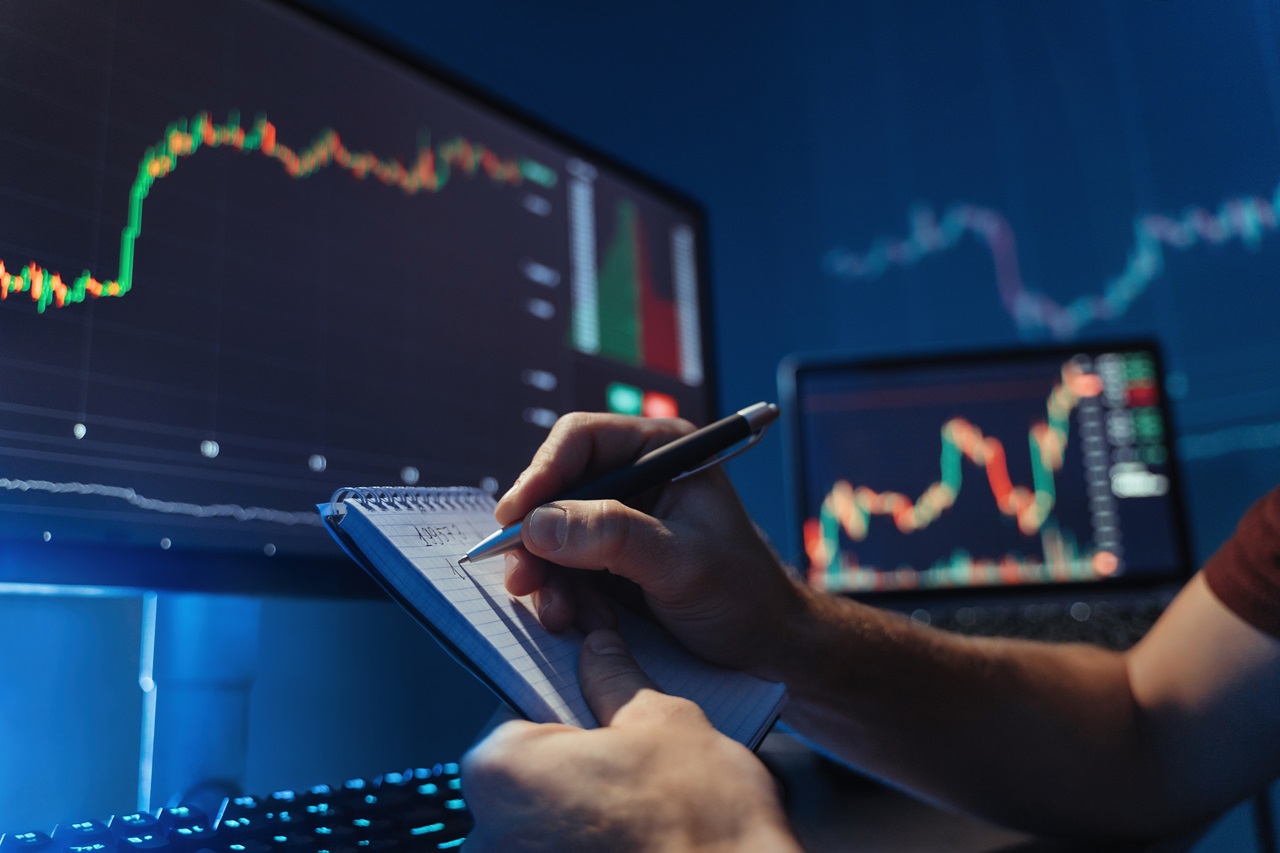
In a world where finance meets technology, there's a new wave of savvy traders who are thriving off the volatility of cryptocurrencies. Using quantitative analysis, these expert traders have found a high-profit, data-based trading strategy. Understanding and employing this analytical method is not just for Wall Street insiders anymore - you, too, can capitalize on market trends in crypto trading and potentially boost your earning potential.
"Quantitative analysis in crypto trading is hinged on using complex mathematical and statistical models to identify opportunities in the market. It's all about leveraging big data to make informed, strategic decisions. And guess what? You can master it."In this article, we will explore the intricacies of quantitative crypto analysis, providing a comprehensive roadmap that can guide you in navigating the ever-evolving cryptocurrency market. Whether you're a seasoned trader or just dipping your toes into the world of digital currencies, this guide is designed to equip you with the insights necessary to spot promising trends and make more data-driven investment decisions.
Basics of Quantitative Analysis in Crypto Trading
Let's dive in deeper into the intriguing world of quantitative analysis in cryptocurrency trading. At its core, quantitative analysis is an approach that uses mathematical and statistical modelling, framework, and research to understand behavior. In trading, quantitative analysts, or 'quant traders', apply this approach to financial and investment decisions. They leverage the vast amount of data available in the crypto markets to remember patterns, predict trends, and coin their trading strategies.
Your journey into quantitative crypto trading begins with understanding the market indicators. These critical pieces of information could include trading volumes, historical prices, order books, and everything in between. By dissecting this data using the lens of quantitative analysis, traders can identify the pivotal points to enter or exit a trade.
Beyond trading volumes and price, some sophisticated traders might consider factors like social media sentiment, regulatory news impacts, and even global economic trends. Given the decentralized and global nature of cryptocurrencies, these elements could make a colossal difference in market movements.
Quantitative analysis will also enable you to discover and exploit arbitrage opportunities in an effective and efficient way. This process generally involves buying a cryptocurrency on one exchange, where the price is low, and selling it on another, where the price is high. This strategy takes advantage of the price differences between crypto exchanges, connecting the dots you wouldn't typically see with a qualitative approach.
Remember, while this analytical approach requires a higher degree of technical skills, it typically yields more precise and actionable results. And in a market as volatile as cryptocurrency, every bit of accuracy can be incredibly valuable.
Importance of Quantitative Analysis in Cryptocurrency Trading
Quantitative analysis in cryptocurrency trading is critical for various reasons. Firstly, the crypto market, unlike traditional markets, operates 24/7. This allows traders worldwide to initiate transactions at any given time, leading to substantial price variations. The constant volatility underscores the importance of quantitative analysis, enabling traders to understand the pattern and make informed decisions.
Secondly, unlike traditional asset trading, crypto trading often sees patterns that aren’t clearly interpretable through qualitative methods. Whilst qualitative analysis leans heavily on intuition or gut feeling, quantitative analysis adds a layer of mathematical probability to trading decisions. This provides a more structured, objective view of market conditions, helping traders sidestep the pitfalls of subjective or emotional trading decisions.
Thirdly, the sheer size and diversity of today's cryptomarket, with thousands of tokens each having their own distinct patterns, make manual analysis a virtual impossibility. Quantitative analysis is a feasible approach that allows you to decode large volumes of data faster and more accurately. Using proven mathematical models and algorithms, traders can spot emergent patterns, predict future price movements, and thus make informed trading decisions.
Finally, the evident unpredictability of the crypto market also necessitates quantitative analysis. Unlike equity markets which experience regulatory changes, crypto markets are often influenced by unforeseeable events, such as abrupt regulatory measures or technological advancements. Quantitative analysis can assist in identifying trends amidst the chaotic and unpredictable market scenarios.
In conclusion, quantitative analysis in cryptocurrency trading is not an option but a necessity. It provides traders with a robust framework to identify market trends and make profitable trade decisions. It’s not merely about maximizing profit; it’s also about minimizing risk in a market that’s known for its high volatility.
Tools and Techniques for Quantitative Crypto Analysis
Whenever you're carrying out quantitative analysis for your cryptocurrency trading, there are several key tools and techniques you need to know about.
The first is algorithmic trading software. This utilizes complex algorithms to analyze and interpret vast amounts of data and predict future market trends. Examples include platforms like AlgoTrader and CryptoTrader. They offer easy-to-use interfaces and a wide range of tools, allowing you to back-test strategies before implementing them in real-world situations.
Another vital tool is a data aggregator platform—an essential part of any cryptocurrency trader's toolkit. These platforms (like CoinMarketCap or CryptoCompare) provide a wealth of real-time information, including price data, volumes, market cap information, and historical chart data. By watching these figures carefully, you can start to understand the patterns and trends that underpin the market's movements.
In addition to these, trading bots play a significant role in quantitative crypto analysis. These automated systems execute trades on your behalf based on set criteria. While they can't guarantee success, using a trading bot can significantly enhance your efficiency, allowing you to trade around the clock and capitalize on opportunities that you might have otherwise missed.
As for techniques, backtesting is a must in your strategy. This practice allows you to apply your trading strategy to historical market data, assessing its effectiveness in different scenarios. Additionally, the application of machine learning and artificial intelligence can provide a predictive edge, allowing your trading models to evolve and adapt as market conditions change.
Identifying Crypto Market Trends through Quantitative Analysis
Quantitative analysis allows you to distinguish major market trends in the volatile world of cryptocurrency. It's your compass in this fast-paced exchange landscape, helping you navigate and make calculated trading decisions. More often than not, your financial success in crypto trading will depend heavily on your ability to spot these trends.
There are several methods to identify prevailing market trends. One common approach is the Moving Average (MA), which calculates the average price of a cryptocurrency over a specific period to smoothen short term price fluctuations and highlight long-term trends. Another popular technique is the Relative Strength Index (RSI), a momentum oscillator that measures the speed and change of price movements to determine overbought or oversold conditions. When the RSI is above 70, it typically indicates overbought conditions, while an RSI under 30 suggests oversold conditions.
Understanding these tools and how to apply them properly can give you an edge in identifying potential market shifts and trading opportunities. However, it's crucial to remember that these indicators should not solely drive your trading decisions. They serve as a guide, intended to be used alongside other quantitative and qualitative analytical methods to enhance your overall trading strategy and increase your chances of success in the crypto market.
Interpreting Quantitative Analysis Results for Crypto Trading
When you interpret the results of your quantitative analysis, it's important to keep in mind that the numbers don't tell the whole story. There's always a degree of uncertainty because the market is influenced by many unpredictable variables. Still, with the right approach, you can extract meaningful insights from your analysis.
For starters, look for patterns and trends in your data. Numerical data may initially appear as a sea of information, but careful observation can reveal important movements. If the price of a certain cryptocurrency is consistently moving upward, for instance, there might be a positive overall trend.
It can also be useful to compare and contrast different sets of data. If two cryptocurrencies typically increase in value under similar market conditions, the identification of that correlation can inform your trading decisions. Or perhaps, the value of cryptocurrency A tends to decrease when cryptocurrency B rises. Recognizing this inverse relationship is equally valuable.
Furthermore, it’s crucial to consider market volume in conjunction with price. A surge in price accompanied by high volume might indicate strong investor interest and could signal continuing momentum. Conversely, a rise in price on low volume might caution against a potential reverse trend.
A final tip for interpreting your quantitative analysis is to consider the broader market conditions, including economic and geopolitical factors. These variables can significantly sway crypto markets, so marrying your quantitative analysis with an understanding of the wider context can lead to better-informed trading decisions.
Above all, keep learning and refining your analysis techniques. Quantitative analysis for crypto trading is a skill that improves with practice and patience.
Strategies for Capitalizing on Crypto Market Trends
So, you've equipped yourself with the necessary tools, honed your analytical skills, and are seeing the signals. Great! The question now is - how do you take these insights and use them to carve out profits in the crypto market?
The strategy you adopt for capitalizing on market trends largely depends on your trading goals and risk tolerance. However, regardless of your specific approach, the basic principles of proper risk management and consistency should underpin your trading activities. Let's delve into some actionable strategies:
Leverage Trading
Leverage trading, or margin trading, is a method used by many experienced crypto traders. This strategy allows you to borrow funds in order to trade larger amounts than what is currently available in your account. Let's say you have conducted your quantitative analysis and believe the price of a certain cryptocurrency will rise. A leverage trading platform will enable you to greatly multiply your potential profits. However, this approach also multiplies potential losses if your prediction is incorrect. Therefore, leverage trading should be attempted with utmost caution and preferably, after gaining considerable trading experience.
Swing Trading
Swing trading is another strategy you can adopt. This involves buying and selling cryptocurrencies based on the 'swings' in market prices. The goal is to capture a portion of a potential price move. Through your quantitative analysis, you may identify a trend where a particular crypto asset is likely to rise in price in the short term. You buy into this asset and sell when your analysis predicts a potential decline. Swing trading requires patience and nerves, as the price might 'swing' against your position before it ultimately moves in your direction.
Long-Term Holding
Based on your analysis, you might be bullish about the long-term prospects of a certain cryptocurrency. In this case, your strategy might involve buying and holding the asset for an extended period - months or even years. This method is known as 'HODLing', derived from a misspelling of 'Holding' in cryptocurrency communities. Long-term holding might be less stressful as it doesn't require constantly watching the market. But remember: for this strategy to work, your analysis has to be spot-on regarding the long-term trend of the asset.
In conclusion, knowledge is power in cryptocurrency trading. Quantitative analysis equips you with that knowledge, helping you seize opportunities and ultimately, capitalize on market trends.
Risk Management in Quantitative Crypto Trading
Risk Management plays an indispensable part in the field of Quantitative crypto trading. It’s the mechanism that enables you to survive the volatile market scenarios and helps make sure you’re still in the game for the long run.
One important aspect of risk management in quantitative crypto trading is to only invest what you can afford to lose. Cryptocurrency, with its notorious volatility, should never be your only primary source of income, especially not when you're starting out. You should always have a backup plan and sufficient reserves to fall back on.
Diversification
This is the cardinal rule of any form of trading or investing — and cryptocurrency trading is no exception. By spreading your investments across a wide variety of coins and tokens, you reduce the impact of a single coin's downturn on your overall portfolio. Combining this with quantitative crypto analysis can help to identify potential coins for diversification.
Regular Monitoring and Rebalancing
Given the volatile nature of the cryptocurrency market, you need to stay up-to-date with your investments and their ongoing performance. The effectiveness of your portfolio’s diversification can shift according to market trends, and regular monitoring allows for adjustments either to guard against potential losses or to capitalize on rising opportunities.
Emotional Control
It's vital to keep emotions in check when trading in cryptocurrency. Making decisions based on fear or greed can lead to hastily entering a trade, overstaying in a losing trade, or exiting a winning trade too soon. Use quantitative analysis to make informed decisions based on hard facts rather than emotions.
Using Stop Loss and Take Profit Levels
Incorporating 'stop loss' and 'take profit' levels in your trading strategy can be an effective way to manage risk. Stop loss prevents severe losses by automatically selling your asset when the price drops to a certain level. Similarly, take profit sells your asset when it reaches a certain profit level. Both can prevent rash decisions during highly volatile market situations.
To recap, embracing risk management in quantitative crypto analysis is essential. It goes a long way in keeping potential losses at bay and preserving your capital, allowing you to take advantage of future market opportunities.
Future Perspectives: Quantitative Analysis in Crypto Trading
The constant advancements in technology promise exciting future implications for quantitative analysis in crypto trading. As we look ahead, we can anticipate significant shifts in the way we analyze and invest in cryptocurrencies.
One such shift is the increasing role of Artificial Intelligence (AI) and Machine Learning (ML) in quantitative crypto analysis. These technologies can process vast amounts of data at top speeds, enabling thorough and accurate analyses. With AI and ML, it's plausible to predict more precise market trends, leading to more informed strategic decisions.
Automation is another area set to transform the landscape of quantitative crypto trading. Automating trading operations based on predetermined conditions reduces the required time and effort. It also minimizes errors, ensuring a smoother trading process and potentially improving profitability.
Next, we might witness a surge in community-driven quantitative analysis models. As the interest in cryptocurrency rises, so does the number of dedicated communities. These communities often share their knowledge and algorithms, driving development, and refining existing models. This type of collaboration might lead to more innovative and effective trading strategies.
Lastly, we can expect the regulation landscape around cryptocurrency trading to evolve, which will undoubtedly impact quantitative strategies. Understanding and adhering to these regulations will be crucial to maintaining a sustainable trading operation.
In summary, the future is bright for quantitative crypto analysis. Technological advancements, community collaboration, and evolving regulations will all play a part in shaping its future. It's an exciting time to be a part of this dynamic and ever-evolving field, ripe with possibilities for traders looking to capitalize on market trends. The key is to stay informed, agile, and open to new technologies and methodologies that can enhance your trading performance.



